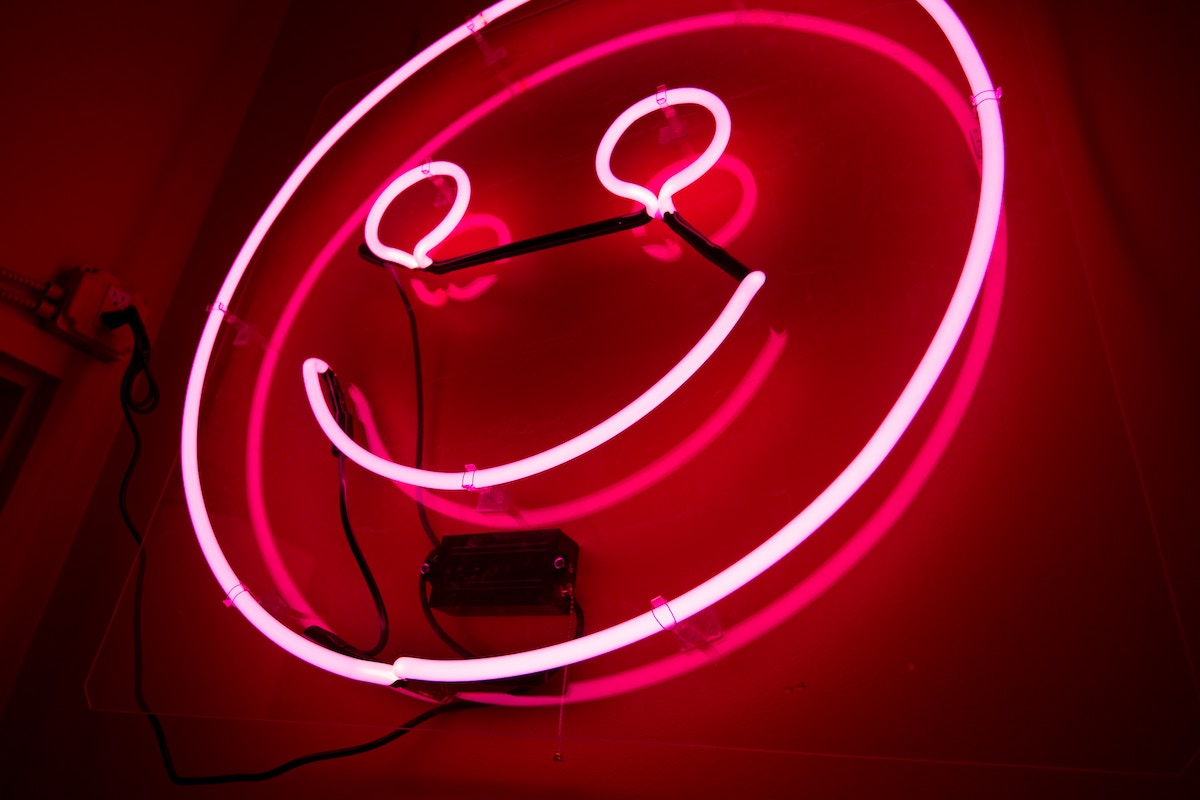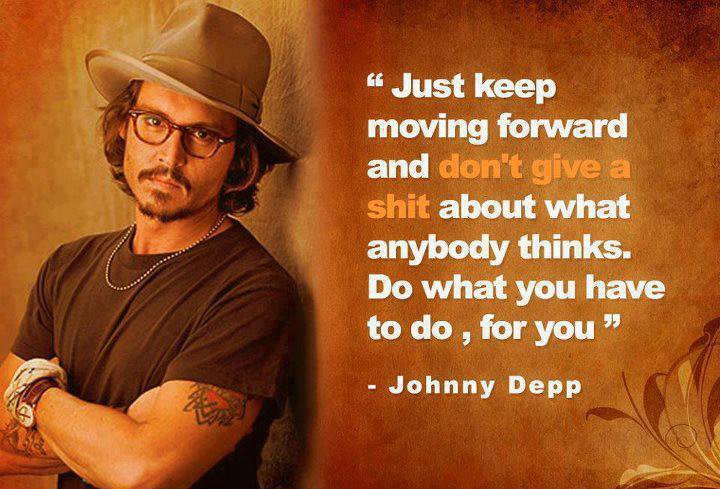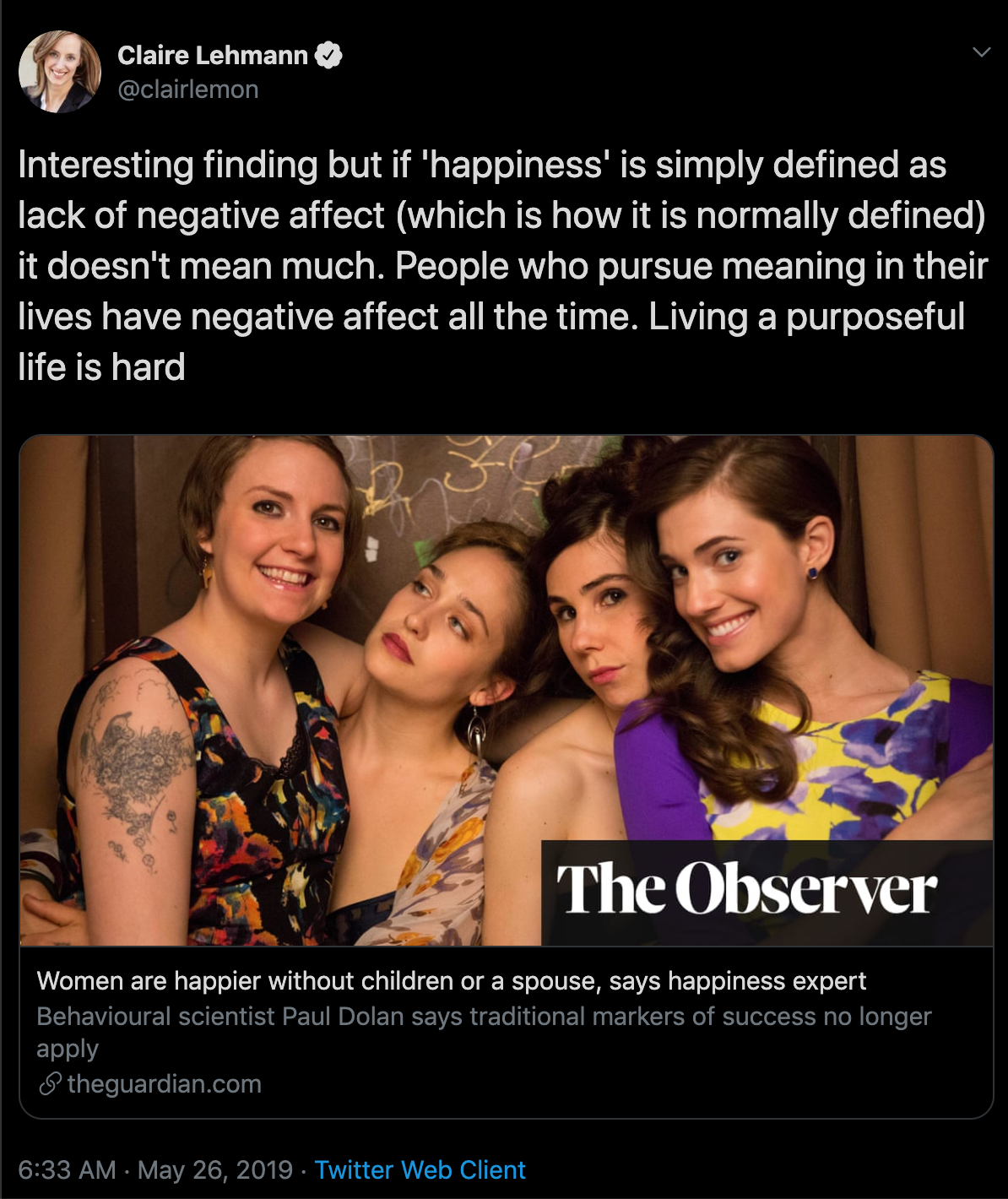Entertainment
Life, Liberty, and the Pursuit of....What Exactly?
The same is true of happiness and positivity. They’re not mere feelings. They are behaviors.

On June 28, the morning after her eyebrow-raising theatrics at the second Democratic debate, New Age high priestess-cum-presidential aspirant Marianne Williamson retweeted this:
The power of your mind is greater than the power of nuclear radiation. Visualize angels dispersing it into nothingness.
— Marianne Williamson (@marwilliamson) March 29, 2011
While Williamson’s candidacy is itself certain to disperse into nothingness, legible between the lines of the guru’s flakiness is a profound insight about the most misunderstood and misguided totem in American life: the idea that positive and/or happy thoughts foster positive and/or happy outcomes. The same belief in “mind power” that elicits groans and derision when rendered in 280 characters is woven through the fabric of American life. American culture has evolved a unique view of the mind’s relationship to the external world; not in the sense of an esoteric disquisition on the nature of consciousness, but rather in the sense of spoon-bending—a view of life wherein positive thinking enables us to bend life to our respective desires. Ergo:
- The attitude is the action.
- The belief is the behavior.
- A happy outlook begets happiness.
These are intoxicating and uplifting notions—that have nothing to do with establishing priorities or setting realistic goals, and may actually, in the end, lead to disaster. Such notions also tend to be associated with a degree of self-love that is unbecoming in an adult.

One might say that the Founders laid the groundwork for all this by writing the pursuit of happiness into America’s Declaration of Independence, alongside such less capricious goals as life and liberty. And certainly since lifestyle coaches like Tony Robbins commandeered pop culture in the early 1980s, a positive mental attitude (PMA) has been framed as the sine qua non of happiness and everything else that is good in life. Which is, of course, what you’d expect from something more powerful than nuclear radiation.
Indeed, merely questioning positivity is considered sacrilegious. I learned this firsthand in 2005 when I published a book skeptical of the excesses and outright scams endemic to the $10 billion self-help and motivational industry. I did dozens of call-in shows, and callers were decidedly unhappy with me: “What kind of person criticizes positive thinking?” “Someone who has researched it,” I would reply.
In my book I had set out to answer these questions:
- How much of the self-help liturgy had bled over into society at large? (A lot.)
- Could the happiness gurus demonstrate any repeatable correlation between a positive mental attitude and positive outcomes? (No.)
- Are there reasonably universal keys to happiness and fulfillment? (Well…sorta.)
Such questions become relevant anew for reasons aside from candidate Williamson. After a several-year hiatus (thanks, mostly, to the global recession), happiness and aspirational thinking are back in the spotlight.
An article in the Atlantic puckishly asks, ‟Are McMansions making everyone unhappy?” and concludes that, because suburbanites rank themselves against neighbors who own even larger McMansions, there is no getting off this hamster wheel. A Guardian piece hammers what looks like the final nail into the coffin of the familiar ‟have it all” trope championed by early feminists. The author ruefully reports that, having compared “levels of pleasure and misery in unmarried, married, divorced, separated, and widowed individuals,” an academic has found that “unmarried and childless women are the happiest subgroup in the population.” Quillette, too, has waded into the churning waters of ‟happiness science” with a piece alleging “malpractice” on the part of that same academic.

Also back on the front page is world-famous self-improvement guru Tony Robbins himself, whose signature line may be: “There’s no such thing as failure. There is only feedback.” Well, Robbins just got some feedback from his publisher, which canceled his book deal after BuzzFeed reported that he berated victims of rape and domestic violence, used racial slurs, and exposed himself to female staffers and fans. (The trifecta of professional suicide in today’s era of #MeToo and #BLM.)
The Robbins affair is the latest embarrassment for a movement that has seen its share of them since Tony became the Pope of Empowerment. But America’s obsession with incubating positivity and happiness has always amounted to less than meets the eye. For at least a half-century we’ve been putting the cart before the horse when it comes to aspirational thinking, and evidence suggests that individuals and society are both suffering for it.

It was in 1983 that 23-year-old Tony Robbins debuted his “firewalk experience,” which still defines his pricey motivational shindigs in the same way the crashing chandelier defines Phantom of the Opera. Participants would gambol across hot coals to demonstrate the triumph of mental resolve over physical pain, and that pain is a mental construct. More potent was the meta-message: Adversity itself is a construct. If you can master flaming coals, surely you can land that dream job or launch that new business or bed the hottest guy or gal around. You can find enduring happiness, no matter the obstacles.
But if firewalks work, it’s not because of the mind’s dominion over physics. Rather, the gimmick depends on physics—specifically, laws governing heat dispersion. Coals are surprisingly poor conductors, especially when covered in ash, as at Robbins events. And the balls and heels of the feet can withstand a fair amount of heat before burning, providing that people walk at a brisk pace and lift their feet into the cooler air between steps, as instructed. In short, a firewalk must be performed under controlled conditions; when that critical balance is disturbed, attendees are carted off to the ER with burns, as happened during Robbins firewalks in San Jose and Dallas.
Nevertheless, Robbins’s early firewalks crackled into an inferno of positivity that inspired scores of imitators, catching the eye of the eventual éminence grise of the movement dubbed “Happyism“: Oprah Winfrey. Oprah brought into the living rooms of her 48 million (!) weekly viewers an eclectic cast of inspirational rock stars—this week Robbins, then Williamson, then Eckhard Tolle, and so on. Their books became blockbusters overnight. Their seminars went standing room only the day they were announced.

But Oprah gave viewers, in an overarching sense, permission to obsess over their own wants. This plangent message stood in stark contrast to the so-called Greatest Generation’s twin themes of service and sacrifice. Oprah spearheaded a one-woman rebellion against the behavioral tic known as codependency, begging viewers to stop tying their well-being to others’ needs. Her handpicked gurus offered new ways of thinking that upended everything Americans had been taught about prudence, planning, and deferred gratification. And they unrelentingly sold personal empowerment. You have within you the power to transcend. The gurus’ trademark themes said it all: Awaken the giant within! A course in miracles! Zero limits! Living in the now! The power of now! Your best life now! Now! Now, now, NOW!
‟Look out for No. 1,” previously said with ironic derision, became a cultural rallying cry. New Age religious leaders even found a way of making self-love sound like a Commandment. Texas pastor Joel Osteen, author of Your Best Life Now, built his estimable Lakewood Church by assuring congregants that, ‟God wants us to be prosperous!” Harvard began offering courses in Happiness Studies that wait-listed the moment they appeared in catalogs.
Then, in 2007, The Secret appeared. Arguably the most unflinching homage to self-love ever created, the book/DVD combo from Australian New Ager Rhonda Byrne also succeeded in mainstreaming beliefs once identified with, say, schizophrenia. Its core concept, the Law of Attraction, insisted that we are all “living magnets” who transmit vibes to shape life to our expectations—which is why you had to be really careful about those expectations. Byrne blamed victims of Hurricane Katrina and 9/11 for failing to emit sufficient collective positive energy to repel disaster. (Oh yes she did.) Overall, though, she preferred to accentuate the positive: “There is not anything any human cannot be, do or have…not a single thing. No limits whatsoever.”
A contributor to the project, James Arthur Ray, likened the Universe to a gargantuan genie waiting impatiently to obey your commands. And if you dared to wonder how that genie reconciled the billions of competing commands arriving from earth…bite your tongue! Granular thinking was just the kind of heresy that just might invite hurricanes or theocratic terrorists into your life.

The Secret achieved media ubiquity: Oprah, Larry King, GMA, Today, network specials. Worldwide, an astonishing 30 million people bought the book. The law of attraction became the de rigueur topic at gatherings. Derivative workshops sprang up everywhere. Corporate training managers began invoking Secret-inflected thinking at meetings: Risk aversion and contingency planning became unwelcome signs of fatalism. Increasing portions of the considerable sum that companies invested annually in training ($86 billion today) were earmarked for speakers and “wilderness programs” designed to instill impregnable positivity. In these sessions, common sense went out the window. I attended a real-estate training seminar in which the speaker assured the 250 attendees—from the same real-estate powerhouse—that all of them could be the company’s No. 1 salesperson the following year. Did they groan or burst out laughing? No, they began back-slapping one another and cheering wildly.
A year later, the economy tanked and the genie began coming for people’s jobs, homes, and retirement savings. But if the Crash of 2008 demonstrated that magical thinking wasn’t foolproof, the truth was actually worse. It became clear that the me-first, no-limits mindset popularized by Oprah and brought to its zenith by Byrne was itself a factor in America’s financial vulnerability. All of the recession’s major woes were to some degree creatures of unchecked optimism.
For decades, the nation had maintained one of the lowest personal saving rates in the free world, but, by 2007, that rate had dipped as consumers splurged every nickel they earned and then some. Americans simply stopped saving for rainy days—why plan for failure? Consumer debt skyrocketed. Unqualified buyers accepted mortgages from banks that had no business writing them, an unholy alliance that assumed ever-escalating property values. Financial firms created new classes of investments that were basically glorified Ponzi schemes relying on a circular faith in The Market and the limitless hunger for more. Within two short years, millions of people lost their homes. Thousands of retirement funds lost half their value. The unemployment rate doubled.
But some of James Arthur Ray’s disciples paid a much steeper price at his October 2009 Spiritual Warrior retreat. The climax of the $9,695 event was an extreme sweat lodge ceremony that, like a firewalk on steroids, was supposed to demonstrate the mind’s ability to overcome even the most inhospitable physical conditions. Three participants did not overcome. Ray went to jail for negligent homicide, and the gurus of positivity went into hiding.
Adversity focuses priorities. Few people think much about whether their marriages are optimally satisfying when the sheriff is padlocking the house or the fridge is empty. When natural disasters occur, we roll up our sleeves and help one another. This happened following the unnatural disaster of 2008. For a while, America was sensible and philanthropic. But, in more recent years, as the economy roars back and the lessons of our erstwhile profligacy fade, narcissism has retaken center stage. Once again, it’s all about you and your ability to meet your needs by sheer dint of your will. Today’s “relationships” columns showcase pieces with navel-gazing titles like, ‟The Life-Changing Magic Of Validating Your Own Feelings,” or “You Deserve More,” or “Leaving You For Me.” Collectively, such tripe makes it sound as if you’re the only person in the relationships you have.
Self-help titles again dominate nonfiction best-sellers—and they’re edgier and pander more bluntly to narcissism than ever. My favorites: You Are a Badass, Unfuck Yourself. How to Stop Feeling Like Shit, Choosing Me before We.
The positivity movement increasingly infects even medicine. Each year, cancer charlatans bank billions by persuading dupes that they can beat the disease through some regimen that “harnesses the body’s positive healing energies.” Not a few cancer patients die needlessly because they defer or dispense with conventional treatments. One 2017 study pegged the overall five-year survival rate for patients undergoing conventional cancer treatment at 78 percent, as against 54 percent for those who went the touchy-feely route. Baseless positivity kills. Besides, it is offensive to tell a woman facing stage 4 ovarian cancer, with its dismal five-year survival rate of 17 percent, that what she mostly needs is to keep her spirits up and fortify her will to live. No, what she mostly needs is a world-class oncologist, perhaps a nice bucket list vacation or two, and a will.
So successful have such fraudulent appeals been at siphoning off patients that mainstream medicine has taken notice. Advertising from major cancer centers conveys outlandish expectations for the curative powers of hope, according to an NIH study. Major hospitals are also turning to so-called integrative healthcare—an amalgam of proven medicine and, well, non-medicine that appeases New Age sensibilities. This pads billings while producing a more cheerful patient with the identical prognosis as before. One industry journal titled its coverage of the phenomenon, ‟Medicine with a side order of mysticism.”
Above all, we have inspirational memes with their endless paeans to personal empowerment. On Twitter, the following quote from actor Johnny Depp recently caught my eye:

This sentiment is in keeping with a society-wide movement—most visible in college culture—to ‟mollycoddle” our young, as Johnathan Haidt and Pamela Paresky put it in an essay for the Guardian. This has plainly backfired, they argue, citing spiking rates of depression and suicide among American youth. The US suicide rate in 2016 was up 34 percent for teenage boys and an astonishing 82 percent for girls, over a baseline period of 2006–2010.
It is counterproductive to imply to young people that they live in a cocoon of never-ending fulfillment, with nary a hostile sentiment to intrude. ‟If we overprotect kids and keep them ‘safe’ from unpleasant social situations and negative emotions,” write the authors, ‟we deprive them of the challenges and opportunities for skill-building they need to grow strong. Such children are likely to suffer more when exposed later to other unpleasant but ordinary life events….” They never become antifragile, Nassim Taleb’s catchy adjective for entities that grow stronger when tested, like bones, or the immune system—or coping skills.
If we’d been paying attention, we would have already learned this lesson from America’s public schools, which made lab rats of three generations of school kids while inadvertently conducting the world’s most damning empirical study of positive thinking. The scholastic self-esteem movement eliminated everything from honor rolls to red ink as schools sought to shield underperforming students from the stigma of failure, even if it meant “temporarily” relaxing standards. The educational process was wholly reconfigured to support ego development.
In the decades since, SAT scores, grade inflation, graduation rates, America’s performance in international STEM testing, and other metrics have demonstrated that scholastic greatness is not what augmented self-esteem promotes. Worse, administrators discovered that those temporary relaxations had to be institutionalized systemically when it was found that students couldn’t succeed later in their in their academic careers, either.

The movement did, however, yield a bumper crop of entitled narcissists. As psychologist/author Jean Twenge observes in Generation Me: Why Today’s Young Americans Are More Confident, Assertive, Entitled…and More Miserable Than Ever Before, schools loosed on society several generations of young people who expect their needs to be met. Twenge describes a 30 percent jump in students who scored above-average for narcissism during the most intense self-esteem-building activity. Additionally, as if foreshadowing Taleb’s points about antifragility, the educational system was shielding kids from developing the resilience that allows mature adults to process adversity.
Meanwhile, psychologist Roy Baumeister told me about one of the most troubling unintended consequences of self-esteem building: “You run the risk of producing kids who can’t tolerate challenges to the façade you’ve built up in them.” Baumeister’s collaborator in one study, Brad Bushman, put it this way in Science Daily, “If kids begin to develop unrealistically optimistic opinions of themselves, and those beliefs are constantly rejected by others, their feelings of self-love could make them dangerous to those around them.” So, if you feel that you deserve a beautiful partner or a better job, but the beautiful partners and managers in your orbit disagree, then they are the ones who need an attitude adjustment. When this entitlement mindset meets underlying pathology, you get a tragic headline. This seems to be apparent in the rise of the very angry incel community.
Not every dream is achievable for every dreamer. For every man who does what he “has to do for himself” and becomes Johnny Depp, there are hundreds on the unemployment line or behind bars. Does the fact that Mark Zuckerberg, Bill Gates, and Lady Gaga dropped out of college to fulfill their dreams mean that you can drop out and repeat their success? It does not. And how does one maintain cohesion in a nation where 325 million people just do what they want to do for them and refuse to “give a shit” how their behavior affects others?
For 16 years, beginning in the mid-90s, the prickly Dr. Laura Schlesinger built a radio franchise on contempt: for gays, ‟shack jobs,” career-minded moms, and ‟unwed mothers.” But she must get props for popularizing at least one enduring gem: “Love is not a feeling, it is a behavior.”
“It doesn’t matter if he tells you he loves you all day long and then sweeps you off your feet at night,” she might tell a woman stuck in a relationship with a romantic but chronically unreliable man. “Does he miss mortgage payments? Does he mess around? That’s not love.”
The same is true of happiness and positivity. They’re not mere feelings. They are behaviors. And the emotional states associated with them are less causes than results. A positive mental attitude is the result of achievement, not its predisposing condition. Happiness is the result of a way of living, not the affectation of perpetual good humor that magically self-fulfills—fake it till you make it! Happiness also is “more of a stable steady state than a series of adrenaline rushes,” as Martin Seligman, the so-called father of positive psychology, told me.
Long ago, my father spoke of the paradox of happiness: that those most desperate for it run a grave risk of ending up miserable. Forever chasing the high of the moment, they live sybaritic, disorderly lives. They have strings of relationships without meaning, children without relationships; they walk out on jobs that “stop meeting their needs.” Pursuit of a more genuine happiness may entail many moments that do not feel especially happy—moments of sacrifice, self-denial, and painful compromise. As an example, you do not get pregnant and instantly have an agreeable child who gets straight A’s, lands a great job, sends you flowers, and visits on holidays, forever enriching your life. You have months of discomfort and then the pain of labor. You have tantrums and bullying and broken hearts and college to pay for. Divorces. Maybe worse.
The highway to happiness is a toll road. That is an unpopular message in these empowered times, which may explain why the childless single women in that Guardian story deem themselves “happy” by today’s narcissistic standards. But as the editor of this magazine, Claire Lehmann, tweeted in response:

Besides which, happiness-mania may in and of itself be psychologically damaging. The psychologists I interviewed for my book were unanimous in the belief that this compulsive taking of the pulse of one’s happiness cannot possibly be good for the psyche: It’s a form of neurosis that too often leaves one feeling that “you are never quite on track,” said Twenge. Or as Seligman told me: “Well-being cannot exist just in your own head. Well-being is a combination of feeling good plus having good relationships and achievement.”
Happiness marches to its own drummer. You don’t know in advance what’s going to provide enduring satisfaction. It may end up being the opposite of “your dreams.” The big worry in putting the cart before the horse in these matters isn’t that the cart doesn’t move; it’s that the impatient horse, his view of what lies ahead obscured, may push you over a cliff.






